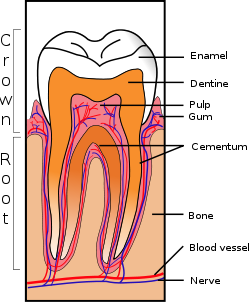- Pulp (tooth)
-
Pulp (tooth) 
Section of a human molar Latin pulpa dentis Gray's subject #242 1118 MeSH Dental+pulp The dental pulp is the part in the center of a tooth made up of living connective tissue and cells called odontoblasts.
Contents
Anatomy
Each person can have a total of up to 52 pulp organs, 32 in the permanent and 20 in the primary teeth. The total volumes of all the permanent teeth organs is 0.38cc and the mean volume of a single adult human pulp is 0.02cc. Maxillary central incisor has shovel shaped coronal pulp with three short horns on the coronal roof and triangular in cross section. Cuspid has the longest pulp with elliptical cross section.
Crowns of the teeth contain coronal pulp. The coronal pulp has six surfaces: the occlusal, the mesial, the distal, the buccal, the lingual and the floor. Because of continuous deposition of dentin, the pulp becomes smaller with age. This is not uniform throughout the coronal pulp but progresses faster on the floor than on the roof or side walls.
Radicular pulp is that pulp extending from the cervical region of the crown to the root apex. They are not always straight but vary in shape, size and number. The radicular portion is continuous with the periapical tissues through the apical foramen or foramina.
Apical foramen is the opening of the radicular pulp into the periapical connective tissue. The average size is 0.3 to 0.4 mm in diameter. There can be two or more foramina separated by a portion of dentin and cementum or by cementum only. Most infections spread through the apical foramen from the pulp to periapical tissue.
Accessory canals are pathways from the radicular pulp, extending laterally through the dentin to the periodontal tissue seen especially in the apical third of the root.
Structural features
The central region of the coronal and radicular pulp contains large nerve trunks and blood vessels.
This area is lined peripherally by a specialized odontogenic area which has three layers (from innermost to outermost)
- Cell rich zone (of Rinaggio); innermost pulp layer which contains fibroblasts and undifferentiated mesenchymal cells.
- Cell free zone (zone of Weil) which is rich in both capillaries and nerve networks.
- Odontoblastic layer; outermost layer which contains odontoblasts and lies next to the predentin and mature dentin
Cells found in the dental pulp include fibroblasts (the principal cell), odontoblasts, defence cells like histiocytes, macrophage, granulocytes, mast cells and plasma cells.The nerve plexus of Raschkow is located central to the cell-free zone.
Clinical significance
An inflammation of a pulp is known as pulpitis. Pulpitis can be extremely painful and in serious cases calls for root canal therapy[1].
Functions
The primary function of the dental pulp is to form dentin (by the odontoblasts)
Other functions include
- Nutritive: the pulp keeps the organic components of the surrounding mineralized tissue supplied with moisture and nutrients;
- Sensory: extremes in temperature, pressure, or trauma to the dentin or pulp are perceived as pain;
- Protective: the formation of reparative or secondary dentin (by the odontoblasts).
Endodontology (ICD-9-CM V3 23.0-23.2+23.7, ICD-10-PCS 0C?W-X) Diagnostic tests Electric pulp test - Thermal test - Percussion test
Dental radiographyArmamentarium and material Amalgam - Apex locator - Files and reamers - Gutta-percha - Dental dam - Rotary technology - Sodium hypochlorite - Silver points - Eucalyptol - Saline - EDTAEndodontic procedures Dental anatomy (TA A05.1.03, GA 11.1112–1124) Teeth Maxillary teeth Incisor: Central incisor, Lateral incisor, Canine
Premolar: First premolar, Second premolar
Molar: First molar, Second molar, Third molarMandibular teeth Incisor Central incisor, Lateral incisor, Canine
Premolar: First premolar, Second premolar
Molar: First molar, Second molar, Third molarParts Crown: Cusp (Cusp of Carabelli)
Pulp · Root canal (Apical foramen)
Cementoenamel junction · Enamel · Dental-enamel junction · Dentin · Dental papilla
Dental alveolusReferences
Categories:- Parts of tooth
Wikimedia Foundation. 2010.

